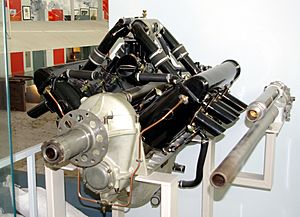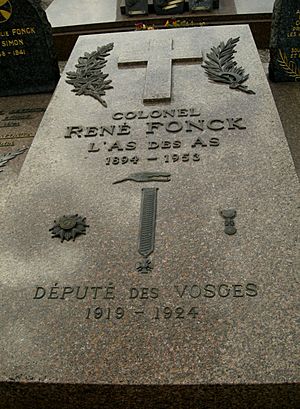René Fonck facts for kids
Quick facts for kids
René Paul Fonck
|
|
|---|---|

René Fonck wearing the Légion d'honneur
|
|
| Born | 27 March 1894 Saulcy-sur-Meurthe, Vosges, France |
| Died | 18 June 1953 (aged 59) Paris, France |
| Allegiance | France |
| Service/ |
Infantry, French Air Service |
| Years of service | 1914–1918 1937–1940 |
| Rank | Colonel |
| Unit | C47, Spa103 |
| Battles/wars | First World War Second World War |
| Awards | Grand Officier of the Légion d'honneur Médaille militaire Croix de guerre Military Cross (United Kingdom) Distinguished Conduct Medal (United Kingdom) Croix de guerre (Belgium) |
Colonel René Paul Fonck (born March 27, 1894 – died June 18, 1953) was a very famous French pilot. He became the top fighter pilot for the Allied forces during the First World War. He is still known as the "all-time Allied Ace of Aces."
Fonck officially achieved 75 victories in air battles. He shot down 72 planes by himself and shared credit for three others. He was given the high honor of being made an Officer of the Legion of Honor in 1918. Later, he became a Commander and then a Grand Officer of the Legion of Honor.
Contents
Early Life and Military Start
René Fonck was born in a small village called Saulcy-sur-Meurthe in France. This was on March 27, 1894. He finished school when he was 13 years old.
Even though he loved planes from a young age, he was first rejected from the air force. This happened when he joined the army in August 1914. Instead, he trained as a combat engineer. He dug trenches and helped fix bridges.
Becoming a Pilot
Learning to Fly (1915-1916)
Finally, on February 15, 1915, Fonck was allowed to train as a pilot. He learned to fly at St. Cyr and Le Crotoy. He started by flying Caudron G III planes. These were used for watching enemy movements.
In May 1916, his observer was killed by an anti-aircraft shell. Fonck himself almost died a few weeks later. He claimed his first enemy plane in July 1916, but it was not officially confirmed.
On August 6, he forced a German Rumpler C.III reconnaissance plane to land behind French lines. This was his first confirmed victory. He shared this win with his observer, Lieutenant Thiberge. This success earned him the Médaille militaire award.
Joining the Famous Storks (1917)
By March 1917, Fonck had flown for over 500 hours. This was a huge amount of flying time back then. On March 17, he shot down another German Albatros plane.
When he was 23, Fonck was invited to join the famous Escadrille les Cigognes (the Storks Squadron). This group was the world's first fighter wing. Georges Guynemer, France's top pilot at the time, was also in this group.
Fonck joined Spa 103, one of the Storks' squadrons. He flew the SPAD VII plane. He quickly became a "flying ace" by May 13, meaning he had five confirmed victories. He continued to score more victories throughout 1917.
Fonck was known for being very professional and precise. He used math and his knowledge of planes to fight. He was very careful and would often sneak up on enemy planes from above. He was also incredibly accurate with his shots. He often needed only a few bullets to shoot down a plane. He preferred quick, decisive attacks over long dogfights. He could also spot enemy planes from far away.
Fonck flew a special SPAD XII fighter plane. This plane had a 37mm cannon that fired through the propeller. He is believed to have shot down 11 German planes using this unique weapon. Later, he flew the successful SPAD S.XIII plane, which had two machine guns.
Top Ace (1918)
Fonck's victories continued to grow in 1918. He had double victories on January 19. He added five more in February, seven in March, and three in April.
On May 9, he had an amazing day. After a friendly bet with two American pilots, Fonck took off late due to fog. Between 4:00 PM and 4:05 PM, he shot down three enemy reconnaissance planes. A few hours later, he shot down three more. He focused on these planes because they directed artillery fire. He shot down six planes in just three hours!
He added two more victories on May 19 and five in June. By July 18, he had 53 victories, tying him with Guynemer. The next day, he shot down three more planes. This made him surpass Guynemer's record. Guynemer had died in September 1917.
Fonck added four more victories in August, reaching 60. On September 26, he again shot down six enemy planes in one day. This time, three of them were Fokker D.VII fighter planes.
By October 30, he had 72 victories, matching the top Allied ace, William Avery Bishop. He then shot down two more planes the next day and one more after that. He finished the war with 75 confirmed victories.
Fonck claimed 56 victories in 1918 alone. This number by itself would have made him France's top ace. Unlike many other aces, Fonck was never wounded. Only one enemy bullet ever hit his plane. He also avoided the most dangerous air combat, never shooting down observation balloons.
Despite his incredible skill, Fonck was not as popular with the French public as Guynemer. Fonck was quiet and kept to himself. He spent his time planning missions and staying fit. He often talked about his achievements, which made him seem arrogant to others. His fellow pilots respected his skills but found him distant. However, he was chosen to carry the flag of the French Air Force in the victory parade.
After the War
After World War I, Fonck returned to normal life. He wrote a book about his war experiences called Mes Combats in 1920. His fame helped him get elected as a Member of Parliament for the Vosges region from 1919 to 1924.
In the 1920s, Fonck tried to win the Orteig Prize by flying across the Atlantic Ocean. He convinced Igor Sikorsky to design a special plane, the Sikorsky S-35. But on September 21, 1926, Fonck's plane crashed during takeoff. Two of his three crew members died. Charles Lindbergh won the prize seven months later.
Fonck later returned to military aviation. He became an Inspector of French fighter forces from 1937 to 1939.
During World War II, some people questioned Fonck's loyalty. This was because he had met with German leaders like Hermann Göring. However, Fonck was actually trying to help France. He was ordered to talk to Göring to arrange a meeting with Adolf Hitler. Fonck tried to warn French leader Philippe Pétain not to meet Hitler. Fonck was later arrested by the Gestapo and put in a prison camp.
After the war, a French police investigation cleared Fonck completely. They found that he was loyal to France and had even worked with French resistance leaders. He received the Certificate of Resistance in 1948. This award recognized his brave actions for France's freedom.
René Fonck stayed in Paris but often visited his home region of Lorraine. He died in Paris from a stroke at age 59. He is buried in his home village of Saulcy-sur-Meurthe.
Famous Quotes
- "I put my bullets into the target as if I placed them there by hand."
- "I prefer to fly alone... when alone, I perform those little coups of audacity which amuse me..."
See also
 In Spanish: René Fonck para niños
In Spanish: René Fonck para niños
- Ivan Kozhedub, a World War II pilot with 62 victories.
- List of World War I flying aces
- List of people on the cover of Time Magazine: 1920s – August 23, 1926



